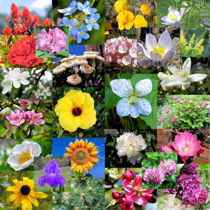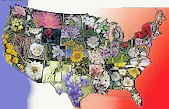Delaware State Flower
Peach Blossom

(Prunus persica)
Adopted on May 9, 1895 ; 1953
The peach blossom, (Prunus persica,) was originally adopted as the floral emblem of the State on May 9, 1895, was designated the state flower in 1953, it was named as the official state flower in recognition of peach tree orchards yielding thousands of dollars worth of crop worth at that time.
Passage of the act to adopt the peach blossom, (Prunus persica,) on May 9, 1895, was prompted by Delaware's reputation as the "Peach State," since her orchards contained more than 800,000 peach trees yielding a crop worth thousands of dollars at that time.
Delaware State Flower: Peach Blossom

Peaches were cultivated in China before written history, and moved to Persia (Iraq) along silk trading routes. The epithet persica denotes Persia, which is where Europeans first obtained peaches. Greeks and especially Romans spread the peach throughout Europe and England starting in 300-400 BC. Peaches came to the new world with explorers of the 16th-17th centuries, with Portuguese introducing it to S. America and Spaniards to N. America (Northern Florida/Georgia coast). Native Americans and settlers distributed the peach across N. America into southern Canada, and it is cultivated in 2/3 of the 48 contiguous states today.
A small tree with a spreading canopy, usually 2-3.5 m in cultivation. Trees are short-lived, generally living only 15-20 years, and even less in cultivation (e.g., the average tree life expectancy in Georgia is 8 years). Leaves are linear with acute tips, folded slightly along the midrib, sickle-shaped in profile
Characteristics of the Peach Tree and Blossom
- Leaf: Alternate, simple, lanceolate, serrated, 3 to 6 inches long, often curved along midrib, shiny dark green above, paler below.
- Flower: Light pink to carmine, to purplish; 1 inch in diameter. Single locule, single seed inside superior ovary, surrounded by hypanthium. Color of inner surface of hypanthium is indicative of flesh color; whitish-green = white, gold = yellow. Petals can be large and showy, or small and curved on margins. Flowers are borne singly on short peduncles (almost sessile), from lateral buds on 1-yr-old wood; usually 1-2 flower buds/node. Ornamental peaches contain fully double flowers, having many petals and a carnation-like appearance. Colors range from dark pink to white.
- Fruit: Fuzzy drupe, 3 inches across, yellow and red, hard, ribbed pit inside encloses the seed, very delicious and juicy, ripens in mid summer.
- Twig: New growth is red and green, later turns gray brown, buds are blunt and gray fuzzy, spur shoot present.
- Bark: Dark gray, initially smooth with elongated lenticels, later splits and becomes irregularly scaly.
Form: A small tree up to 15 feet with a spreading crown.
Delaware State Code
The law designating the peach blossom,as the official Delaware state flower is found in from The Delaware Code, Title 29, Chapter 3, Section 308.
TITLE 29. STATE GOVERNMENT.
PART 1. GENERAL PROVISIONS.
CHAPTER 3. STATE SEAL, SONG AND SYMBOLS.
SECTION 308.
§ 308. State flower.
The peach blossom, as originally adopted as the floral emblem of the State on May 9, 1895, shall be the official state flower. (29 Del. C. 1953, §
508; 50 Del. Laws, c. 289, § 1.)
Taxonomic Hierarchy: Peach
Kingdom: Plantae - Plants
Subkingdom: Tracheobionta - Vascular plants
Superdivision: Spermatophyta - Seed plants
Division: Magnoliophyta - Flowering plants
Class: Magnoliopsida - Dicotyledons
Subclass: Rosidae
Order: Rosales
Family: Rosaceae - Rose family
Genus: Prunus L. - plum
Species: Prunus persica (L.) Batsch - peach
State Floral Emblems








